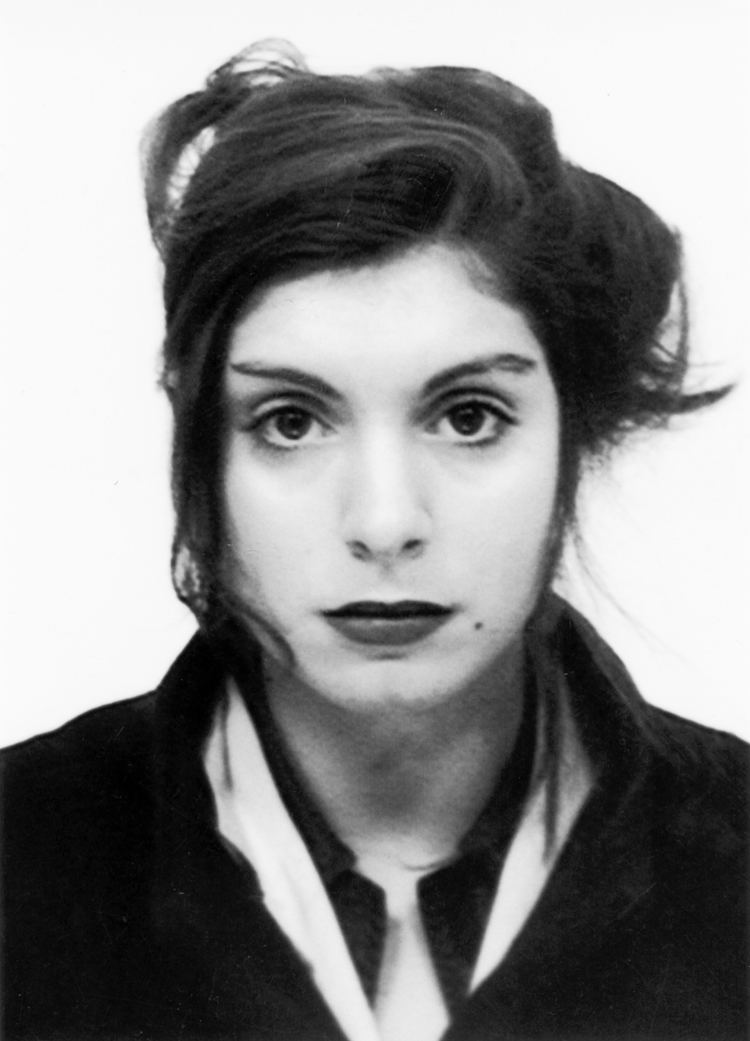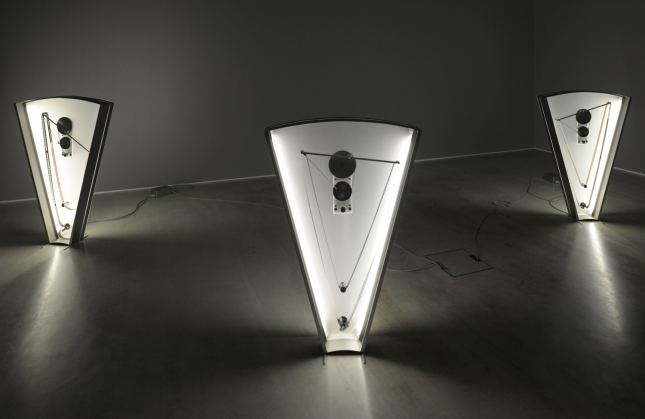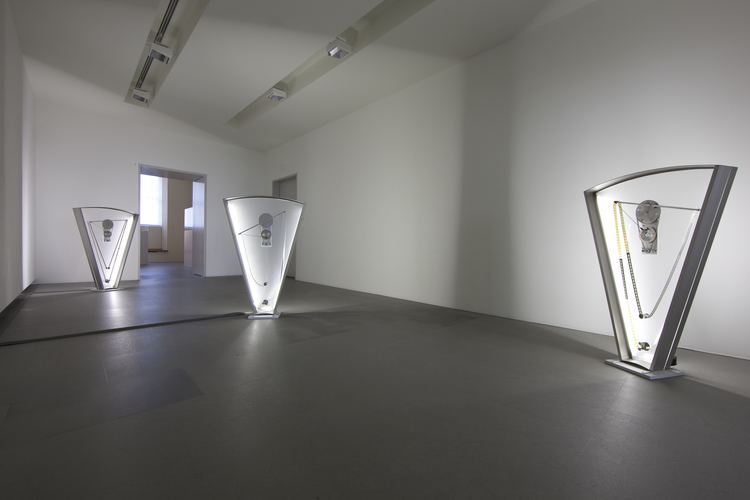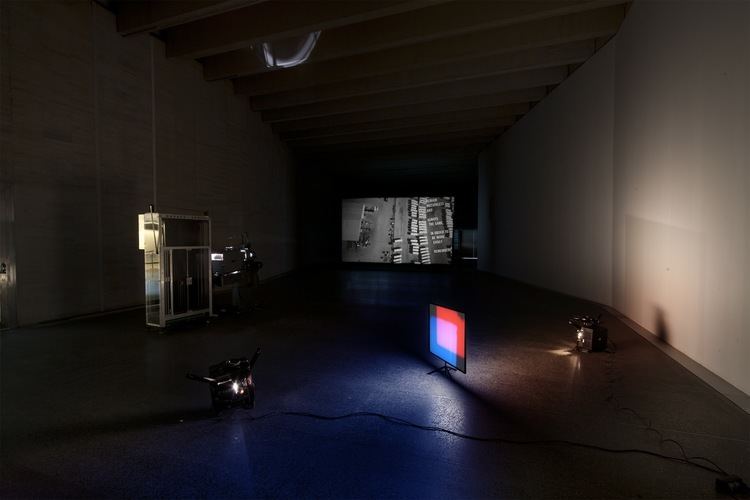Name Rosa Barba | Role Visual artist | |
 | ||
Movies The Hidden Conference: A Fractured Play, Kopietheater 1 Similar People Matthew Buckingham, Paola Pivi, Tacita Dean, Florian Zeyfang, Alberto Garutti | ||
Rosa barba im albertinum in dresden
Rosa Barba (born 1972, Agrigento, Italy) is a Berlin-based visual artist. Barba is known for using the medium of celluloid and its materiality to create cinematic film installations, sculptures and publications. She exhibits in galleries and museums internationally.
Contents
- Rosa barba im albertinum in dresden
- Rosa barba the color out of space
- Life and career
- Work
- Film
- Sculpture installation
- Publication
- Filmography sculpture
- Exhibitions
- Awards selected
- References

Rosa barba the color out of space
Life and career

Rosa Barba began at a young age to work with film as sculpture. She very soon began experimenting with moving images using super 8 film. From 1993 - 1995 she studied Theater and Film Studies in Erlangen, Germany. During her studies at the Academy of Media Arts in Cologne (1995–2000) she made her first 16 mm film Panzano] (2000) in which three characters struggle to assign parts among themselves.

Barba has travelled and taken part in several residencies; the two-year residency program at Rijksakademie van Beeldende Kunsten in Amsterdam (2003-2004), Production in Residence, Baltic Arts Center Visby (2006), Villa Aurora, Pacific Palisades, Los Angeles, USA (2006), IASPIS Stockholm (2007-2008) and Artists-in-Residence-Programm der Chinati Foundation, Marfa, Texas.

Many of her works have been sold at auction, including 'PARACHUTABLE' sold at Sotheby's Amsterdam 'Global Contemporary, Rijkakademie' in 2010 for $11,654.

She is part of a group of artists that addresses the importance of film and analogue in the digital age along with other contemporary practitioners such as Matthew Buckingham, Tacita Dean, Luke Fowler, Ben Rivers etc.
Barba lives and works in Berlin.
There have been several articles about Rosa Barba, including 'Art and politics: the 32nd Bienal de São Paulo taps into current sentiments in Brazil' written by Janelle Zara for Wallpaper in 2016.
Work
Central to her conceptual sculptures is bringing projected images, verbal memories, physical, and imagined objects into a non-compliant yet coherent dialogue. They are speculations on the nature of documents as contemporary reflections not as finished products. Yet Barba is interested in not merely only translating the document into art but rather continuously goes back and forth from material to image and image to material. Thus content becomes form and form becomes content.
Barba takes a sculptural approach to film, often taking apart its elements to create new mobile objects and multisensory installations or directing the camera at objects and landscapes with a particular attention to form. In her films the camera is the drawing instrument with a particular interest in formal shapes seeking and outlining objects and landscapes.
Barba's visual conception of time is in direct relation to space. Her films reveal the depth of time in layers - a geological ‘deep time’. In effect this is how she treats the medium of film itself. Through creating new physical and sensual spaces she opens up new perspectives and connections of understanding space.
Barba's work Western Round Table (2007) is one installation example in which the historical and material possibilities are explored, a dialogue between idea and object is created. The artists meeting called “The Western Round Table on Modern Art” took place with participants being modern male heroes of the future like Duchamp, Schönberg or Frank Lloyd Wright. The first meeting took place in 1948 in the Mojave Desert was not documented unlike the following meetings and therefore it has an air of mystery. Barba’s work being more sculpture than film is an attempt to give the meeting form, to stage it. Two projectors each containing excerpts of two different Fellini film soundtracks by Ennio Morricone in a loop are set in dialogue with each other. They are the shadows of the protagonists staring at each other. According to Barba "it is kind of like how we approach history in general. History is also like a sculpture which we look at."
Her series White Museum holds a key position for her expanded spatial definition of sculpture in that the landscape becomes part of the installation. One room of the exhibition space becomes a projection booth in which therein a film projector casts a rectangular field of light towards the outside. Equally part of the museum and exhibition the landscape becomes a three-dimensional film image can be observed from an empty room. The earth turns; the visitor stands still – the visitor finds oneself within the mechanism of control in which one would otherwise be subjected to from the outside. The outer world becomes an image, an idea.
White Museum has been shown in site specific locations: first in 2010 within a solo exhibition at the Centre international d'art et du paysage de l'île de Vassivière, where the surrounding park became part of the installation and the museum itself - the projection machine, then in 2012 in Margate at Turner Contemporary (projection onto the sea), 2013 in Brussels at WIELS (projection onto a street intersection) and in Cork (onto an airport runway) and in 2015 at the Hirsch Observatory in Troy, upstate New York as one of the two part commission for EMPAC (The Color Out of Space) where the projection was directed at the sky.
The artist and curator Ian White writes that Barba's works involves a "subtle interrogation into and co-option of industrial cinema-as-subject via various kinds of what might be understood as 'stagings'—of 'the local', the non-actor, gesture, genre, information, expertise and authority, the mundane—removals from a social realism within which they were observed and which qualifies them as components of the work, to be framed, redesigned, represented. The effect of which contests and recasts truth and fiction, myth and reality, metaphor and material to a disorientating degree that ultimately extends into a conceptual practice that also recasts the viewer's own staging as an act of radical and exhilarating reversal—from being the receiver of an image (a subject of control) to being in and amongst its engine rooms, looking out."
Barba's work is related to avant-garde film and fantasy literature.
Her work has been shown in solo and group exhibitions worldwide. In 2015 among other exhibition will be shown at the MIT Visual Arts Center, Boston and at the Galerie neuer Meister Albertinum in Dresden. Other recent exhibitions include Center of Contemporary Art, Vilnius, Litauen (2014), MAXXI, Rom, Italien (2014), at Turner Contemporary in Margate (2013), Cornerhouse in Manchester (2013), Bergen Kunsthall (2013), MUSAC in Castilla y Leon (2013), at gallery Gió Marconi in Mailand (2013), Kunsthaus Zürich (2012), at Jeu de Paume, Paris, (2012), Contemporary Art Museum St. Louis, the Fondazione Galleria Civica, Trient (2011), im MART, Rovereto (2011), Kunstverein Braunschweig (2011) an at Tate Modern, London (2010) statt.
Barba has participated in the 52nd and 53rd La Biennale di Venezia. At the 56th Biennale Barba is exhibiting Bending to Earth (2015) in [All the World’s Futures, curated by Okwui Enwezor at the Central Pavilion of the Giardini. She participated in the Liverpool Biennale in 2010, in the 2nd Thessaloniki Biennale of Contemporary Art as well as at various festivals and other biennials. In 2010 she curated the group show A Curated Conference at the Museo Nacional Centro de Arte Reina Sofia, Madrid with works from the collection. Afterwards the exhibition was the inspiration for the films The Hidden Conference I-III, which were performatively filmed in various museum depots.
Barba's work belongs to collections such as Louisiana Museum of Modern Art, Humlebæk, Hamburger Bahnhof - Museum der Gegenwart, Berlin, Museo Centro de Arte Reina Sofía, Madrid, MACBA, Barcelona and the Kunsthaus Zürich.
In an interview with Barba, she gave some insight on what she will be working on next: "I recently finished production of a film at Artpace in San Antonio. Next, I am traveling to Sydney and Columbia for the Biennial. In March, I am in a group exhibition as Mass MoCA entitled The Dying of the Light: Film as Medium and Metaphor." Along with what she's planning in the future, she explains how she feels about live performance versus film/cinema: "My Performa piece brought a film to a live performance by using cinema as a new kind of stage. I created a new 35mm film, which was performed as a live event on the cinema screen in Anthology Film Archives’ screening theatre, whilst being fragmented around the space on 16mm films and filmic sculptures, which repeated an individual formal aspect, such as a sentence or a sound. Whilst almost behaving like characters, or stand-ins for the viewer, these films also interact with one another as though they were a splintered ensemble, fading in and out, and accompanied by an electronic musical accompaniment created by Jan St Werner of Mouse on Mars, and a group of professional voiceover actors who were performing live dialogue from various points in space. Subconscious Society – Live is an attempt to archive the last century, suggesting a paradigm shift, which is represented in the form of a social community, inhabiting a transitional realm, as they make a final attempt at assigning and archiving objects from the past. Here the past exists only as a reference to itself and the details of the present are not fully decipherable yet." Also in this interview, she talks about her influences: "Literature has influenced personal and is exposed in my various work. I like to situate my work in a timeless, more precise space – space with a lot of layered time, so the exact time can’t be deciphered anymore, acted out by sound, images and text."
Film
Barba's films develop from situations that form societies and landscapes. Filming with the camera is used like an instrument for drawing and directly shapes the formal properties of an object. She investigates environments and weaves stories of place and people into fictitious narratives that open up new possibilities for interpretation.
For example, in the film Outwardly From Earth's Center that was produced on the Swedish island Gotland during the winter 2006 as a Production in Residence project for the Baltic Arts Center in Sweden, Barba collaborated with the local inhabitants, who also performed in the film, to create narratives and form characters as the filming progressed. Outwardly From Earth's Center is constructed around a fictitious society on a drifting island in danger of disappearing. Gotska Sandön drifts approximately one meter per year and the depiction of the small society trying to stop the movement develops into a surrealistic atmosphere that slowly but surely replaces the experience of what one might consider a beautiful documentary with a more abstract and somewhat absurd picture of people's struggle and vulnerability.
Sculpture & installation
Barba's sculptures and installations are created from the physical and conceptual components of film which dissected, abstracted and compiled and arranged anew. The roles and relations of the various components are questioned and newly defined: the mechanical objects move, speak and become main protagonists in the exhibition space.
For example, the piece Boundaries of Consumption (2012) features a 16 mm projector directed at film cans with silver globes balancing while the film runs through. This spatial constellation becomes a moving shadows of images on the wall that changes in colour and appearance over time.
Publication
Since 2004 Barba has been publishing a series of printed editions parallel to her films as another form to express and dismantle the cinematic organism. She conjugates its repertoire while she disbands and defines the relationships and hierarchies between image and word and like between image and viewer anew. The series Printed Cinema which won the artist book award 2006 at the Ontario Association of Art Galleries is published for specific exhibition spaces and accompanies her films as secondary literature for a limited time. The printed editions present an extended and free form of the exhibited film which reveal the filming process including research material and unused filmic fragments. The edition exists beyond the duration of the film. The filmic projection is translated into printed material and confronted with its conditions, its materiality and temporality. Through the comparison of both media the emphasis on image, language and text and their relationships and overlapping themes are shifted into a new light.
Filmography & sculpture
Exhibitions
Selected solo shows:
